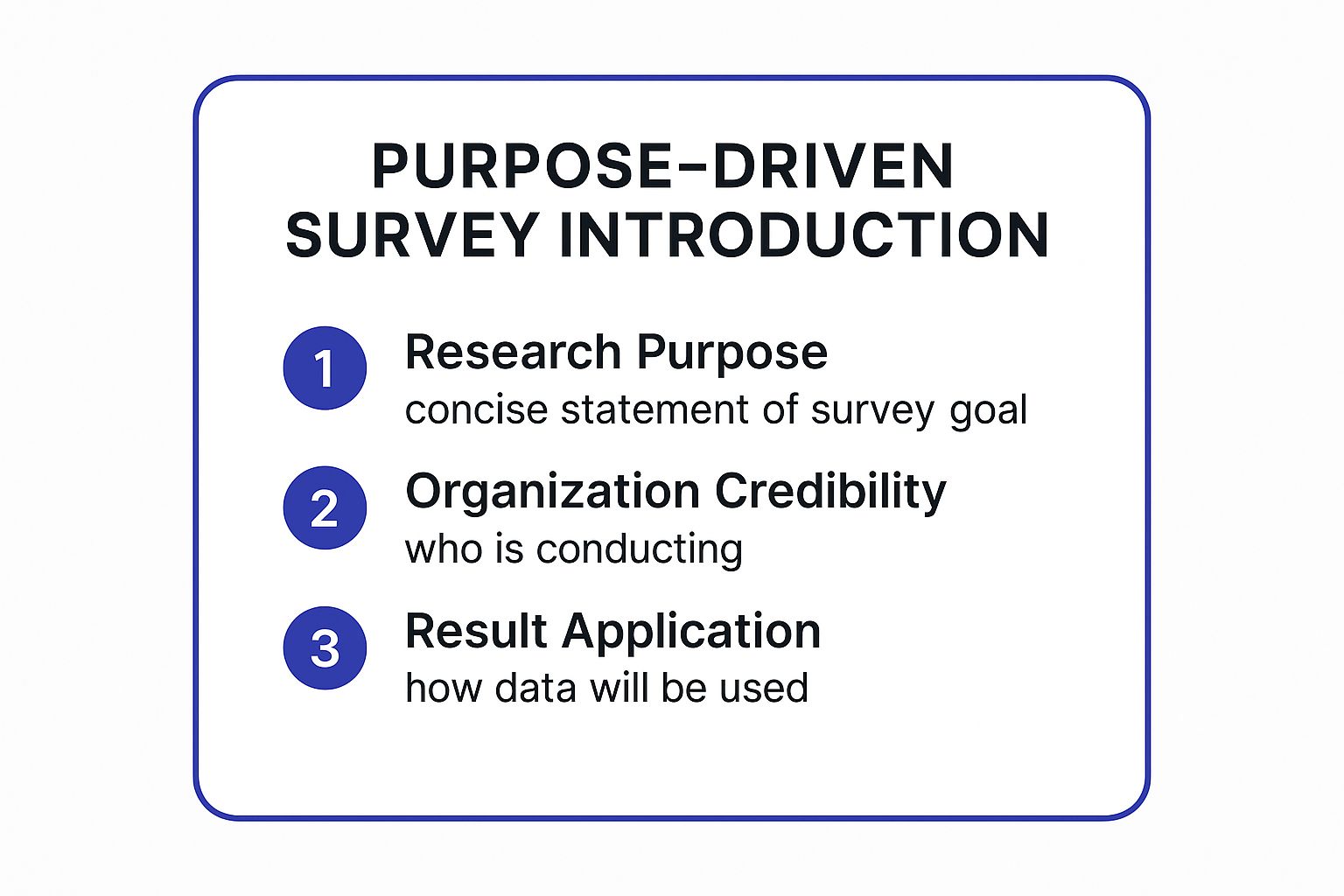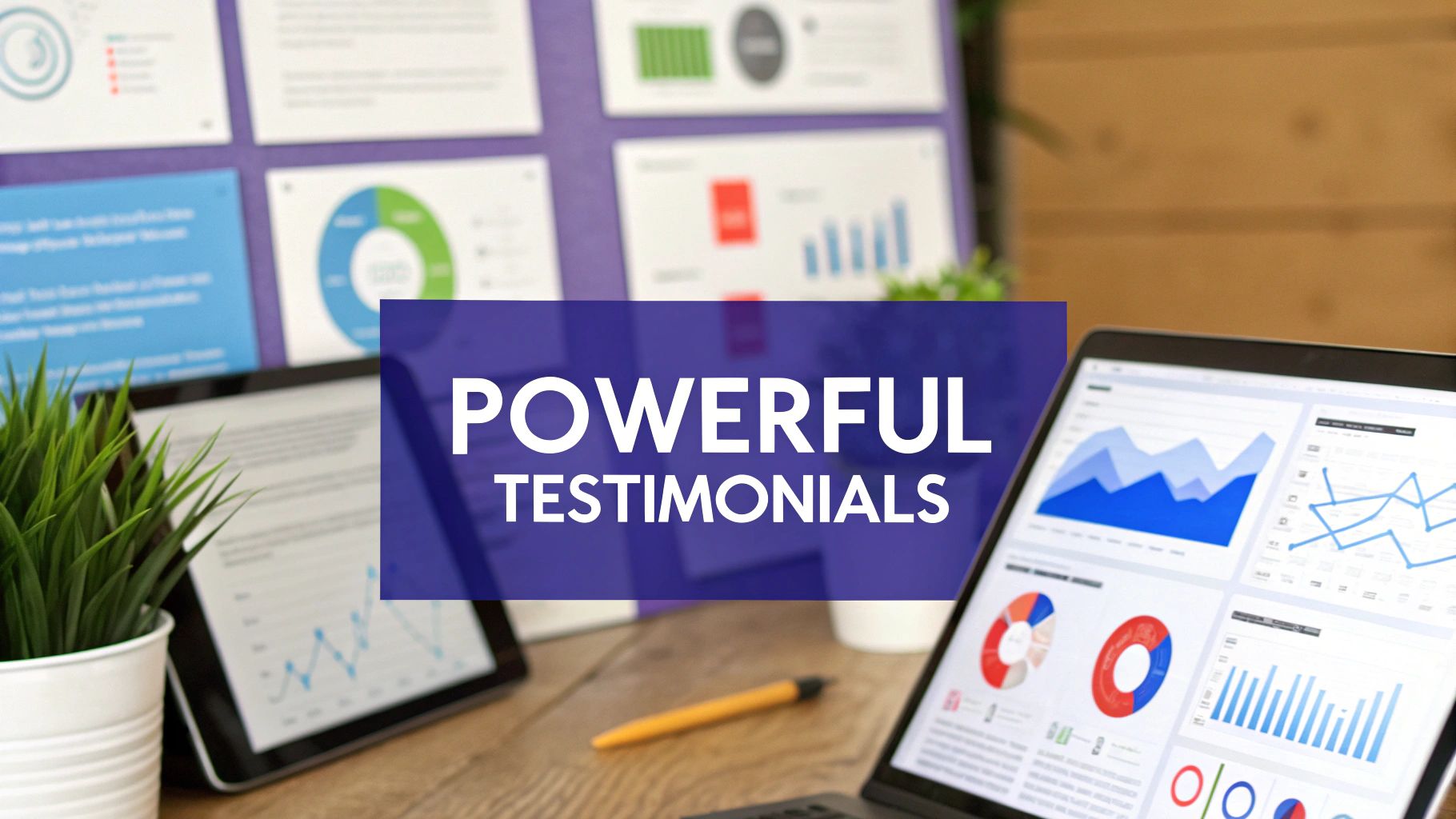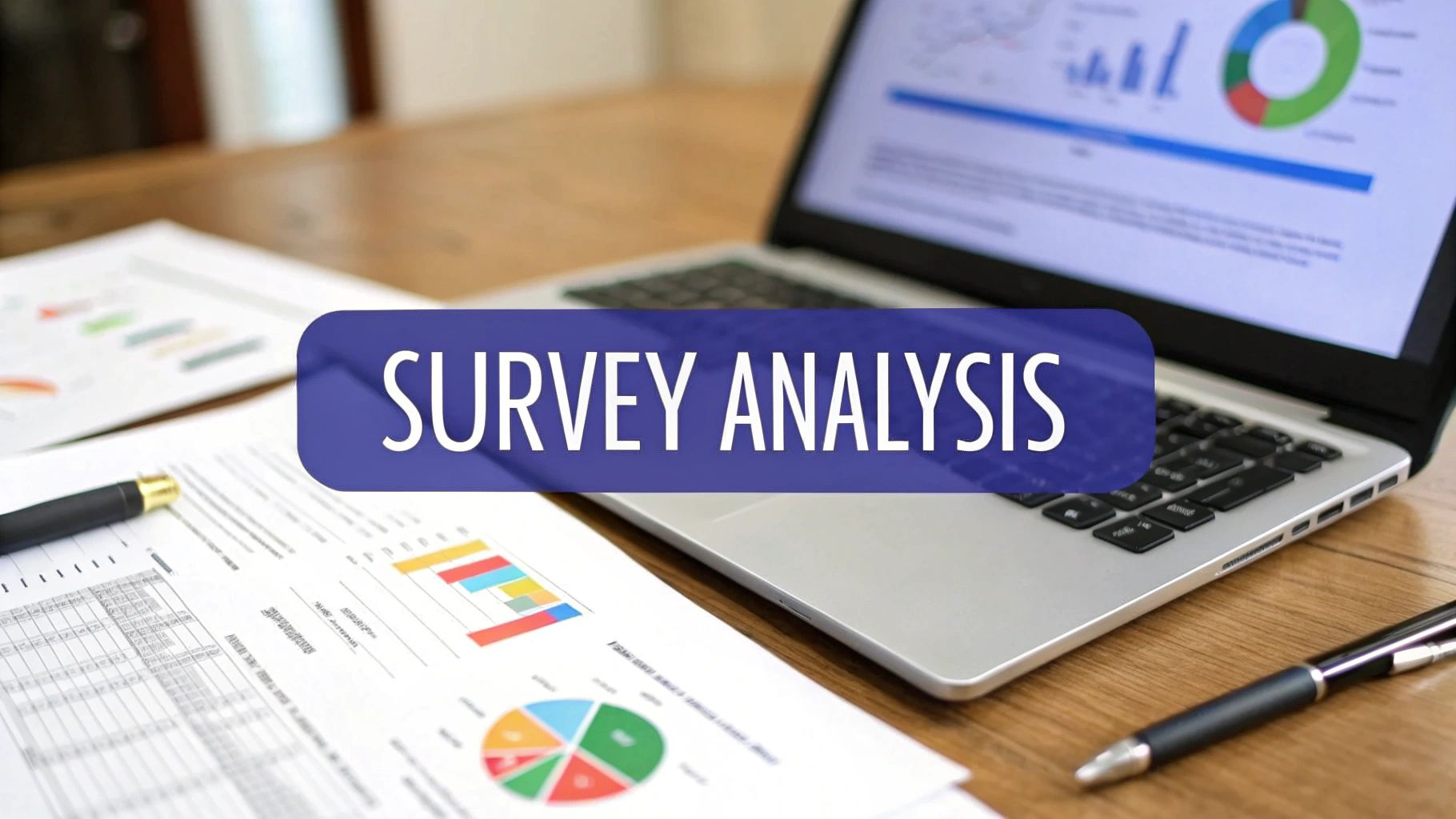7 Winning Sample Survey Introductions for 2025
Boost response rates with these 7 powerful sample survey introductions. Learn proven tactics to engage users and get valuable feedback. Start today!

A poorly crafted survey introduction is a guaranteed way to tank your response rates. Before a respondent even sees the first question, they've already decided whether your request is worth their time. That first impression, lasting only a few seconds, determines if they click "start" or simply close the tab. A vague, generic, or self-serving opening signals a frustrating experience ahead, leading to high abandonment rates and skewed, low-quality data. In contrast, a compelling introduction builds immediate trust, clarifies value, and respects the respondent's time, significantly boosting participation.
This article provides a tactical breakdown of seven powerful sample survey introductions you can adapt and use immediately. We won't just show you examples; we'll dissect why they work and provide actionable takeaways for different scenarios, from customer feedback to market research. You will learn how to structure your opening to:
- Clearly state the survey's purpose.
- Establish a personal connection with the respondent.
- Highlight a direct benefit for their participation.
- Respect their time with a clear estimate.
The goal is to move beyond generic templates and craft openings that feel intentional and genuine. To ensure your survey's opening resonates authentically with respondents, exploring how to humanize AI text for engaging copy can offer valuable insights, even if you're writing manually. Let's dive into the examples.
1. The Purpose-Driven Introduction
The Purpose-Driven Introduction is a direct and transparent approach that gets straight to the point. This method prioritizes clarity by immediately telling respondents who you are, what your survey is about, and why their specific feedback is crucial. It’s built on the principle of respect for the respondent's time and intelligence, fostering trust from the very first sentence.
By leading with your objective, you frame the survey not as an arbitrary request but as a meaningful research effort. This is particularly effective for academic studies, government policy research, or non-profit impact assessments where the "why" is a powerful motivator. This type of introduction sets a professional tone and is one of the most reliable sample survey introductions for formal contexts.
How It Works: A Strategic Breakdown
This introduction builds trust by answering the three core questions a respondent implicitly asks:
- What is this for? (The Purpose)
- Who is asking? (The Organization)
- What will you do with my answers? (The Impact)
Answering these upfront eliminates ambiguity and reduces the cognitive load on the participant, making them more likely to proceed.
Strategic Insight: A purpose-driven intro shifts the dynamic from a transactional "give us your data" to a collaborative "help us achieve this goal." This psychological framing increases the perceived value of participation and can lead to more thoughtful responses.
Example in Action: Healthcare Quality Survey
Imagine a hospital seeking to improve patient discharge processes. A purpose-driven introduction would look something like this:
"Welcome. You are invited to participate in a 5-minute survey conducted by [Hospital Name]'s Quality Improvement Department. Our goal is to understand the patient discharge experience to reduce wait times and improve communication. Your confidential feedback will directly inform new protocols we plan to implement by Q3. Thank you for helping us improve our care."
This example clearly states the purpose (improve discharge), the conductor ([Hospital Name]), and the application (inform new protocols), making it a powerful and effective introduction.
This infographic summarizes the core components of a powerful Purpose-Driven Introduction.

As the visualization highlights, these three elements work together to build a foundation of trust and clarity, encouraging higher completion rates.
2. The Personal Connection Introduction
The Personal Connection Introduction leverages storytelling and shared values to build an immediate emotional bond with respondents. Instead of a formal data request, it frames the survey as a conversation, making the experience feel more human and less transactional. This approach is powerful for building brand loyalty and encouraging candid, heartfelt feedback.

By sharing a brief, authentic story or appealing to a common goal, this introduction transforms the survey from a corporate task into a collaborative effort. It’s highly effective for community-based organizations, founder-led businesses like many SaaS startups, and brands like Patagonia that have a strong ethical identity. This method is one of the best sample survey introductions for fostering a sense of belonging and community.
How It Works: A Strategic Breakdown
This introduction forges a bond by appealing to three key emotional drivers:
- Shared Identity: (Who are we together?)
- Relatable Story: (Why does this matter to me personally?)
- Common Goal: (What can we achieve as a team?)
Addressing these elements makes participants feel seen and valued, not just as data points but as partners in a mission.
Strategic Insight: A personal connection intro shifts the participant's motivation from extrinsic (like an incentive) to intrinsic (a desire to help someone they feel connected to). This often results in higher-quality, more detailed qualitative feedback.
Example in Action: Small Business Customer Feedback
Imagine a small, founder-led coffee shop wanting to understand its local customers better. A personal connection introduction could be:
"Hi, I’m Jane, the founder of The Daily Grind. Eight years ago, I started this shop with a simple dream: to create a welcoming space for our neighborhood. To keep that dream alive and make this place even better for you, I’d be grateful for 3 minutes of your honest feedback. Your thoughts will directly shape our new menu and the community events we host next season. Thank you for being part of our story."
This example establishes a personal connection (I’m Jane), shares a relatable story (a simple dream), and invites collaboration toward a common goal (making the space better), making it a warm and compelling introduction.
3. The Benefit-Focused Introduction
The Benefit-Focused Introduction directly answers the respondent's unspoken question: "What's in it for me?" This approach leads with the value proposition for the participant, framing the survey not as a favor to you, but as an opportunity for them. It taps into fundamental human motivators like personal gain, community improvement, or exclusive access.
This method is highly effective in commercial or community-driven contexts where intrinsic motivation may be low. By highlighting a tangible or intangible reward, you immediately increase the perceived value of participation. Whether it's a discount, a chance to win a prize, or the promise of a better product, this introduction makes a compelling case for the respondent's time and is one of the most popular sample survey introductions for customer-facing businesses.
How It Works: A Strategic Breakdown
This introduction works by creating a clear and immediate incentive that justifies the effort required. It addresses three key considerations for the respondent:
- What do I get? (The Incentive or Benefit)
- How much effort is required? (The Time Commitment)
- Is the reward worth the effort? (The Value Exchange)
By clearly articulating the benefit upfront, you create a simple cost-benefit analysis in the respondent's mind, making "yes" an easy and logical answer.
Strategic Insight: A benefit-focused intro transforms the survey from a request into a transaction. You are offering something of value in exchange for valuable feedback. This reframing can dramatically boost response rates, especially among busy or less-engaged audiences.
Example in Action: SaaS Feature Feedback Survey
Imagine a SaaS company looking for user feedback on a new beta feature before a full launch. A benefit-focused introduction could be:
"Hi [User Name], want to help shape the future of [Product Name]? As one of our most valued users, we're inviting you to a quick 3-minute survey on a new feature we're developing. As a thank you for your feedback, you'll receive a 25% discount on your next month's subscription. Your insights will help us build a better tool for you."
This example immediately presents the dual benefit: influencing the product's direction and receiving a tangible financial reward. It specifies the short time commitment (3 minutes), making the value exchange highly appealing.
4. The Time-Respectful Introduction
The Time-Respectful Introduction directly addresses the single biggest reason people abandon surveys: they are afraid it will take too long. This approach leads by acknowledging the value of the respondent's time, clearly stating the survey's length, and setting accurate expectations from the start. It’s built on empathy and transparency, showing participants that you respect them as busy individuals.
By putting the time commitment front and center, you disarm the primary objection to participation. This method is exceptionally effective for reaching busy professionals, such as executives or healthcare providers, and for mobile surveys where users have limited time and attention. These sample survey introductions build immediate goodwill and can significantly improve completion rates by removing uncertainty.
How It Works: A Strategic Breakdown
This introduction preemptively answers the respondent's most pressing practical questions:
- How long will this take? (The Time Commitment)
- Is it worth my time? (The Value Proposition)
- Can I trust your estimate? (The Credibility)
Clearly addressing these concerns reduces friction and helps the user make a quick, informed decision to proceed, rather than closing the tab out of frustration or doubt.
Strategic Insight: The key to this approach is honesty. Over-promising a short survey time and under-delivering will break trust instantly. It's better to be upfront about a 7-minute survey than to promise a 2-minute one that takes much longer. This honesty is a crucial factor in boosting your survey response rate.
Example in Action: B2B Software Feedback
Imagine a SaaS company seeking feedback from busy product managers on a new feature. A time-respectful introduction would be crafted like this:
"Hi [Name], we know your time is valuable. We would appreciate you taking a quick 3-minute survey to share your experience with our new analytics dashboard. Your feedback is essential for helping us prioritize the right improvements for your team. This survey is mobile-friendly and includes a progress bar so you can see how close you are to finishing. Thank you for your time."
This example immediately states the length (3 minutes), explains the value (prioritize improvements), and adds a trust signal (mobile-friendly, progress bar), making it a highly effective and respectful request.
5. The Social Impact Introduction
The Social Impact Introduction frames survey participation not just as data collection, but as a direct contribution to a greater good. This approach appeals to a respondent's altruism and desire to be part of a positive change, whether in their community, environment, or society at large. It is highly effective for non-profits, academic institutions, and public sector organizations whose work is mission-driven.
This introduction transforms a simple request for feedback into a call to action for social improvement. By highlighting the collective benefit, it makes participation feel meaningful and significant. Organizations like the Pew Research Center and the World Health Organization often use this method to underscore the importance of their work, making it one of the most compelling sample survey introductions for research tied to public welfare.

How It Works: A Strategic Breakdown
This introduction connects with respondents on an emotional and ethical level by answering key underlying questions:
- Why does this matter to society? (The Collective Goal)
- How does my single voice contribute? (The Individual Role)
- What tangible change will happen? (The Promised Outcome)
By framing the survey this way, you tap into intrinsic motivators that are often more powerful than material incentives.
Strategic Insight: The Social Impact Introduction shifts the participant's mindset from "What's in it for me?" to "How can I help?" This fosters a sense of shared responsibility and can result in more earnest and comprehensive responses from people who genuinely care about the topic.
Example in Action: Environmental Policy Survey
Imagine a local government initiative aiming to create new public green spaces. A social impact introduction would be structured like this:
"Help us build a greener, healthier community for everyone. The [City Planning Department] invites you to take this 4-minute survey on new local parks and green spaces. Your input is vital in shaping environmental policies that will increase biodiversity, improve air quality, and provide recreational areas for future generations. By participating, you are directly contributing to a more sustainable future for our city."
This example clearly states the collective goal (greener community), the individual's role (providing vital input), and the tangible outcomes (new parks, better air quality), making it an inspiring and effective call to action.
6. The Expert Endorsement Introduction
The Expert Endorsement Introduction leverages credibility by association. It immediately builds trust and legitimacy by highlighting that the research is backed by respected experts, reputable institutions, or well-known organizations. This method borrows authority, assuring respondents that the survey is part of a serious and professionally managed effort.
This approach is highly effective in specialized fields like medicine, academia, or finance, where expertise is a primary driver of credibility. By showcasing the credentials or reputation of those behind the study, you signal that the research is methodologically sound and its outcomes will be impactful. This makes it one of the most persuasive sample survey introductions for reaching professional or skeptical audiences.
How It Works: A Strategic Breakdown
This introduction works by transferring trust from a known entity to your unknown survey. It answers key implicit questions a respondent has:
- Who is vouching for this? (The Endorser)
- Why should I trust them? (Their Credentials)
- Does this make the survey more legitimate? (The Implied Quality)
By leading with a credible name, you bypass initial skepticism and frame the survey as a valuable contribution to a field the respondent likely respects.
Strategic Insight: An expert endorsement acts as a powerful cognitive shortcut. Instead of evaluating the survey on its own merits, the respondent uses the endorser's reputation as a proxy for quality, significantly increasing their willingness to participate.
Example in Action: Industry Technology Trend Survey
Imagine a tech publication collaborating with a university on a study about AI adoption in software development. An expert-endorsed intro would look like this:
"You are invited to participate in the '2024 AI in Development Survey,' a research partnership between [Tech Publication Name] and the Stanford Human-Centered Artificial Intelligence Institute (HAI). This 7-minute survey aims to map emerging trends in AI tool adoption by developers like you. Your responses will contribute to a public report and academic paper authored by Dr. Jane Lee, a leading expert in developer productivity. Your input is vital for this important research."
This example immediately establishes credibility through the partnership (Stanford HAI) and a specific expert (Dr. Jane Lee), assuring participants of the study's high standards. This is similar to how brands use testimonials to build trust; you can learn more about crafting powerful endorsements to apply these principles effectively.
7. The Problem-Solution Introduction
The Problem-Solution Introduction frames your survey as a direct response to a challenge or pain point that the respondent likely experiences. This method creates immediate relevance and a sense of urgency by first identifying a known problem and then positioning the survey as a crucial step toward finding a solution. It connects with respondents on an emotional level, appealing to their desire for improvement and resolution.
This approach is highly effective because it transforms the survey from a simple data collection exercise into a collaborative problem-solving effort. It is one of the most compelling sample survey introductions for engaging communities, employee groups, or customer bases who are actively dealing with a shared issue. It tells them, "We see this problem, we know it affects you, and we need your help to fix it."
How It Works: A Strategic Breakdown
This introduction grabs attention by tapping into a pre-existing frustration or need. It works by:
- Identifying a Relatable Problem: It clearly articulates a specific pain point the respondent recognizes (e.g., high employee turnover, frustrating software bugs, local traffic congestion).
- Positioning the Survey as a Solution Pathway: It presents the survey not just as questions, but as the mechanism for gathering the insights needed to develop a fix.
- Empowering the Respondent: It gives the participant a constructive role in resolving an issue that directly impacts them, making their feedback feel powerful and necessary.
This method builds a strong "what's in it for me" incentive without offering a tangible reward; the potential solution is the reward itself.
Strategic Insight: The Problem-Solution approach shifts the respondent's motivation from altruism ("I'll help this company") to self-interest ("My feedback can help solve a problem that bothers me"). This intrinsic motivation is a powerful driver for both survey completion and data quality. For a deeper dive into this method, you can explore the Problem-Solution Survey Approach on surva.ai.
Example in Action: Workplace Satisfaction Survey
Imagine a company struggling with high employee turnover. A Problem-Solution introduction could be framed like this:
"We've seen the data on employee turnover, and we recognize the strain it places on our teams. To address this directly, we've created this confidential 7-minute survey. Your honest feedback is essential for helping us identify the root causes of burnout and develop new support initiatives that will make [Company Name] a better place to work for everyone. Help us build the solutions you want to see."
This example validates employee concerns, clearly states the problem (turnover and strain), and empowers them to be part of the solution, making participation feel both urgent and meaningful.
Comparison of 7 Sample Survey Introductions
From Introduction to Insight: Your Next Steps
The journey from a blank survey canvas to a rich dataset of actionable insights begins with a single, crucial step: the introduction. As we've explored through a variety of sample survey introductions, this opening is far more than a simple greeting. It is a strategic tool that sets the stage, builds trust, and directly influences both response rates and the quality of the data you collect. A weak introduction leads to abandoned surveys and skewed results, while a powerful one acts as a magnet, pulling your target audience in and priming them for thoughtful participation.
Mastering the art of the survey introduction means understanding that there is no one-size-fits-all solution. Your choice of approach, whether it's leading with purpose, highlighting a direct benefit, or leveraging a personal connection, must align with your audience, your brand, and the specific goals of your survey.
Your Core Takeaways for Crafting Compelling Introductions
To transform these examples into a repeatable process, let's distill the core principles we've covered. Keep these strategic pillars in mind every time you design a new survey:
- Clarity is King: Your primary objective is to eliminate all ambiguity. A respondent should instantly understand why they received the survey, what it's about, and how long it will take. The Time-Respectful and Purpose-Driven introductions are excellent frameworks for this.
- WIIFM (What's In It For Me?): Every person is subconsciously asking this question. Your introduction must provide a compelling answer. The Benefit-Focused and Problem-Solution examples directly address this, turning participation from a chore into an opportunity for the respondent.
- Trust is the Foundation: Anonymity, data privacy, and a clear purpose are non-negotiable for building trust. Being transparent about how you'll use the data, as seen in the Social Impact and Expert Endorsement introductions, reassures participants that their time and information are valued and secure.
- Context is Crucial: The delivery channel shapes the interaction. A survey introduction for an email campaign will differ from one used in-app. Beyond the initial impression, a well-crafted introduction helps ensure higher quality responses, critical for specialized data collection such as in effective in-app surveys, where user context is immediate and highly relevant.
Ultimately, the most effective sample survey introductions are those that are built with empathy. By putting yourself in your audience's shoes, you can anticipate their questions, address their hesitations, and frame your request in a way that feels respectful and mutually beneficial. This empathetic approach is the thread that connects all the successful examples we've analyzed.
Your next step is to move from theory to practice. Don't just copy and paste these examples. Instead, use them as a strategic launchpad. Mix and match elements, test different hooks, and measure the impact on your response rates. With each survey you launch, you will refine your approach, turning the critical first impression into a reliable gateway for gathering the insights that fuel growth, innovation, and customer delight.
Ready to put these strategies into action without the manual effort? Surva.ai helps you build and deploy intelligent, AI-driven surveys that automatically craft the perfect introduction based on your goals and audience. Stop guessing and start engaging by visiting Surva.ai to see how our platform can transform your feedback collection process.


